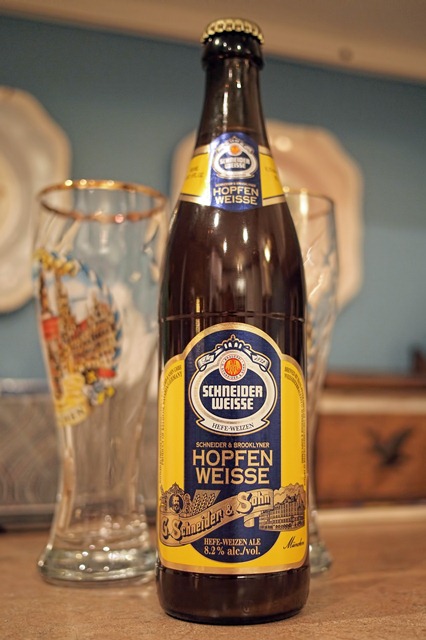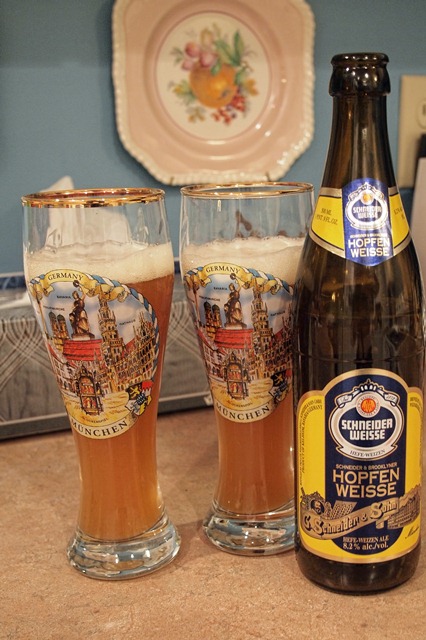Tuesday
Jul102012
Schneiderweisse Meets Brooklyn
 Tuesday, July 10, 2012 at 8:00
Tuesday, July 10, 2012 at 8:00 Over Christmas, we made a trip to the Charleston Beer Exchange to see what kind of German beers they had. While we were pleased to see they carried Augustiner Edelstof Export, we were more excited to try a couple of the beers we'd heard about but hadn't been able to find here. First, we tried the Sam Adams - Weihenstephaner Infinium collaboration. Given that it was a bit of a novelty (a champagne beer), we were more excited to see that they carried the Schneiderweisse-Brooklyn Brewery collaboration.
I've generally enjoyed the Brooklyn brews that I've tried in NY restaurants when travelling. Please don't ask me to tell you which ones, but they are usually a solid choice when you don't know any of the beers on the menu. And I really like Schneider's dunkleweissbier.
Before we get to the collaboration, a bit about Schneider. Officially known as G. Schneider & Sohn, this is Munich's oldest weissbier brewery (founded in 1872) and is still owned by the Schneider family today.
After several expansions and destruction of the Munich facilities in WWII, its beers are produced across Bavaria, with local ingredients such as Hallertau hops. After wheat beer lost its popularity in the mid-1800s, the king decided to sell brewing rights, and the Schneider brewery was born. It's not always the easiest beer to find on store shelves, but it's worth a try. And you can always find it at the historic Schelling Salon.
Back to the collaboration.... according to the back label:
Schneider & Brooklyner Hopfen-Weisse is a collaboration between brewmasters Hans-Peter Drexler of the Schneider Weissbier Brewery and Garrett Oliver of The Brooklyn Brewery. Garrett and Hans-Peter have long admired each other's beers. Now together they bring you a new sensation, a pale weissbock robustly dry-hopped with the Hallertauer Saphir variety grown in the fields near the Schneider brewery. Hoppy, zesty and supremely refreshing, Schneider & Brooklyner Hopfen-Weisse is a delicious blend of Bavarian craftsmanship and American ingenuity.

There actually are two versions of this collaboration:
In the first (which is what we tried), Oliver travelled to Schneider's Kelheim brewery and the two brewmasters used Hallertau Saphir hops to dry hop the brew.
Later, Drexler travelled to Brooklyn (bringing his weissbier yeast with him), and they brewed another version using American hops for the dry hopping.
The dry-hopping technique is also a bit unusual, for a European or a weissbier. Normally, hops are added toward the end of the wort boiling stage. However, this boiling often greatly reduces the aromatic properties of the hops. So, sometimes the brewers add unpasteurized hops to the beer after the wort has cooled in order for the beer to soak up the flavor and aroma of the hops. This is very common for an IPA and is becoming more widely used in the US. It's not very common in Germany, and is quite unusual for a weissbier. In this case, the beer was open fermented for a week, then transferred to another tank to complete the fermentation atop the dry hops. After removing the hops, the beer follows the rest of the weissbier brewing process...adding a little unfermented beer before bottling it and letting a secondary fermentation in the bottles create those lovely little weissbier bubbles.
For any of you home brewers out there, BrewersFriend has some good tips on dry hopping your home brew.

We quite enjoyed this tasting. Collaborations are always fun, and this Hefe-Weizen Ale (8.2% ABV) was something different. It wasn't bitter, but it was a good weissbier for someone who doesn't love theirs so sweet and banana-clovey. Unfortunately we didn't have the chance to compare both versions, but we did find two guys online who reviewed both.
Tweet ...




